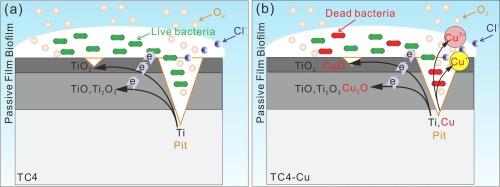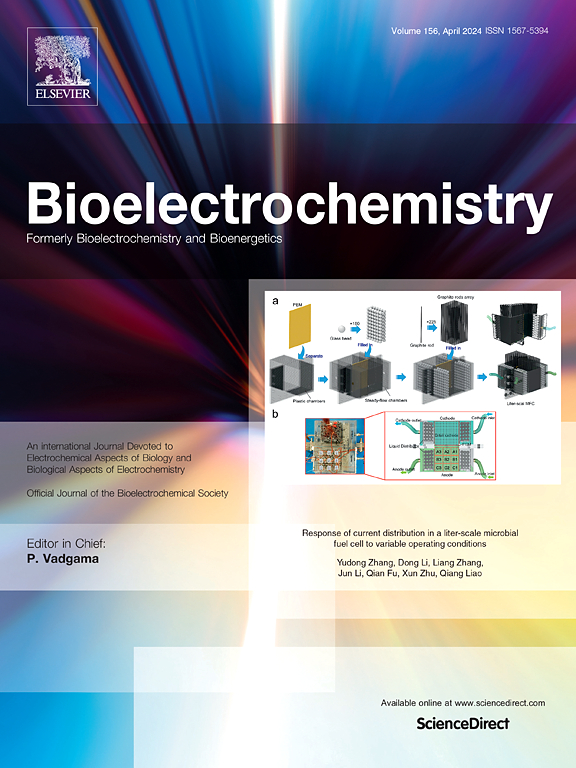添加少量铜的 TC4 可增强对海洋铜绿假单胞菌的耐腐蚀性和生物膜抑制作用。
IF 4.8
2区 化学
Q1 BIOCHEMISTRY & MOLECULAR BIOLOGY
引用次数: 0
摘要
Ti-6Al-4V(TC4)合金因其密度低、比强度高、耐腐蚀性好而被广泛用作海洋工业的结构材料。然而,随着生物污染的急剧变化,一些报道称细菌的主要有害影响给提高抗微生物影响腐蚀(MIC)带来了挑战。解决这一问题的另一个机会是铜微合金化,其灵感来自于在生物医学应用中添加铜。在此,一种添加了少量铜的 Ti-6Al-4V 合金(TC4-Cu)被暴露在接种了铜绿假单胞菌(P. A.)的 2216E 介质中,然后与 TC4 相比进行了研究。与最大点蚀坑深度为 9.6 μm 的 TC4 相比,TC4-Cu 表现出更低的腐蚀电流、更致密的被动膜、更低的重量损失和更弱的点蚀(最大点蚀深度为 0.2 μm)。此外,除了众所周知的杀菌作用外,Cu 离子还能转移形成 Cu2O 和 CuO,构成保护性腐蚀产物,从而提高 TC4-Cu 的抗微生物性能。本文章由计算机程序翻译,如有差异,请以英文原文为准。

Enhanced corrosion resistance and biofilm inhibition of TC4 with slight Cu addition against marine Pseudomonas aeruginosa
Ti-6Al-4V (TC4) alloy is widely utilized as the structural material in marine industries owing to its low density, high specific strength, and favorable corrosion resistance. However, as biofouling drastically alters, some reported the major deleterious effect of bacteria has imposed a challenge to improve microbiologically influenced corrosion (MIC) resistance. A further opportunity for solving this problem is Cu micro-alloying, which was inspired by adding Cu for biomedical applications. Herein, a Ti-6Al-4V alloy with slight Cu addition (TC4-Cu) was exposed to 2216E media inoculated with Pseudomonas aeruginosa (P. A.), and then investigated compared to TC4. TC4-Cu exhibits lower corrosion current, more denser passive film, and lower weight loss with weaker pitting (a maximum pitting depth of 0.2 μm), compared to TC4 with a maximum pitting crater depth of 9.6 μm. Those demonstrated that the presence of Cu significantly improved the MIC resistance, and inhibited the proliferation of P. A., leading to a good antimicrobial efficacy against marine P. A. Moreover, besides the well-known bactericidal role, Cu ions were transferred to form Cu2O and CuO, constituting protective corrosion products, and thus improving the anti-microbial properties of TC4-Cu.
求助全文
通过发布文献求助,成功后即可免费获取论文全文。
去求助
来源期刊

Bioelectrochemistry
生物-电化学
CiteScore
9.10
自引率
6.00%
发文量
238
审稿时长
38 days
期刊介绍:
An International Journal Devoted to Electrochemical Aspects of Biology and Biological Aspects of Electrochemistry
Bioelectrochemistry is an international journal devoted to electrochemical principles in biology and biological aspects of electrochemistry. It publishes experimental and theoretical papers dealing with the electrochemical aspects of:
• Electrified interfaces (electric double layers, adsorption, electron transfer, protein electrochemistry, basic principles of biosensors, biosensor interfaces and bio-nanosensor design and construction.
• Electric and magnetic field effects (field-dependent processes, field interactions with molecules, intramolecular field effects, sensory systems for electric and magnetic fields, molecular and cellular mechanisms)
• Bioenergetics and signal transduction (energy conversion, photosynthetic and visual membranes)
• Biomembranes and model membranes (thermodynamics and mechanics, membrane transport, electroporation, fusion and insertion)
• Electrochemical applications in medicine and biotechnology (drug delivery and gene transfer to cells and tissues, iontophoresis, skin electroporation, injury and repair).
• Organization and use of arrays in-vitro and in-vivo, including as part of feedback control.
• Electrochemical interrogation of biofilms as generated by microorganisms and tissue reaction associated with medical implants.
 求助内容:
求助内容: 应助结果提醒方式:
应助结果提醒方式:


